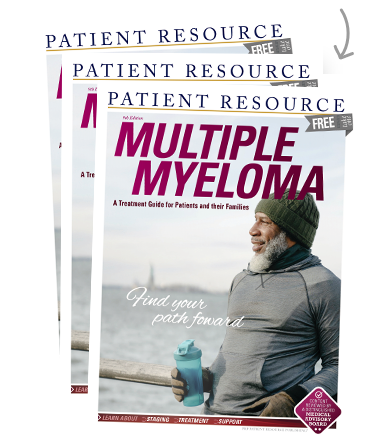Multiple Myeloma
Living with a Chronic Disease
Although your diagnosis will likely alter some of your plans for the future, it does not have to change them completely. Many people with multiple myeloma continue to maintain active, fulfilled lives by approaching their diagnosis as they would any other long-term medical condition. Work closely with your doctor to develop a comprehensive plan that will help you achieve your desired quality of life.
While your doctor coordinates the medical side of your treatment plan, your goal will be to manage your multiple myeloma on a daily basis. As you do, try to be flexible and positive. And keep in mind that having some control at a time when many things feel out of your control may be a source of comfort.
Follow-Up Appointments
Assessing how the multiple myeloma responds to treatment will require ongoing appointments for a variety of tests. It is critical that you make and attend these visits.
Use those opportunities to share any physical symptoms you have (see Helpful Tracking Tools). Find out how your doctor likes to be contacted between visits, such as through a portal or by email. Your input is key to finding disease recurrence and other health issues early.
Medication Adherence
Taking your medication exactly as prescribed by your doctor is called medication adherence, and it is extremely important in the treatment of multiple myeloma. Most cancer therapies are designed to maintain a specific level of drugs in your system for a certain time based on your cancer type and stage, your overall health, previous therapies and other factors. If your medications are not taken as prescribed, or if you miss appointments for your IV infusions, injections or radiation therapy, the consequences can be serious — even life-threatening.
A variety of tools can help you stay on track with medications and appointments:
- Write down when you take your medications and go to appointments (see Helpful Tracking Tools).
- Talk to your pharmacist to ensure you understand how to take your medications.
- Use an alarm on your phone, clock or computer as a reminder.
- Enlist a caregiver to help remind you.
Bone Health
Lytic lesions (holes in bones) are a common side effect of multiple myeloma and its treatments. Your doctor will monitor your bone health through a dual-energy X-ray absorptiometry (DEXA) scan, also referred to as a bone scan. This will happen before treatment begins to get baseline measurements of your bone mass to compare with measurements taken at follow-up appointments.
You can do certain things to help prevent further weakening of your bones and possible injuries:
- Consume foods that are rich in vitamin D to help your body absorb calcium.
- Walk, jog or perform other weight-bearing exercises. This stimulates cells that help grow bones and build muscle.
- Avoid tobacco products.
- Limit your alcohol consumption.
- Reduce your fall risk by installing grab bars in the bathroom, removing throw rugs, using a nightlight, clearing clutter from the floor, enlisting help from others for tasks that require using a ladder, and limiting activities after taking medications that make you tired or dizzy.
- Report pain to your doctor as soon as you feel it.
Lifestyle Approach
Maintaining healthy habits may help you tolerate treatment better, lower the risk of a recurrence and protect against another illness or second cancer.
Good nutrition is crucial. Follow a well-balanced diet of protein, fruits, vegetables, low-fat dairy and fiber. You may have appetite challenges, especially if you have acute Graft-versus-Host Disease following a stem cell transplant. Ask your health care team to connect you with a nutritionist who can help design a food plan that best meets your needs.
Exercise improves your physical fitness, emotional well-being and bone health. It is also a remedy for managing fatigue and may reduce pain from peripheral neuropathy. Even walking for 10 minutes a day offers benefits. Consider swimming if you have bone pain.
Your body needs water to function. Staying hydrated can prevent dehydration, which can worsen some symptoms and side effects. While daily fluid needs vary from person to person based on health, activity level and geographic area, the general recommendation is about 8 to 10 cups of water per day.
Helpful Tracking Tools
These free downloadable tools will help you manage parts of your treatment plan and keep your health care team informed. Your doctor may also provide additional tracking resources to use depending on your treatment.
- Laboratory Test Tracker: Log your lab results to get a bigger picture of your progress. PatientResource.com/MMTestTracker
- Medical Wallet Card: Carry this with you so anyone providing medical care is aware of the medications you are taking. PatientResource.com/Wallet_Card
- Medication Tracker: Staying on schedule with your medications and appointments is easier with this handy tool. Note when each item is complete. PatientResource.com/Medication_Journal
- Side Effects Tracker: Note when a side effect occurs, how long it lasts, how intense it is and if anything makes it better. PatientResource.com/Tracker



